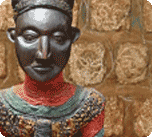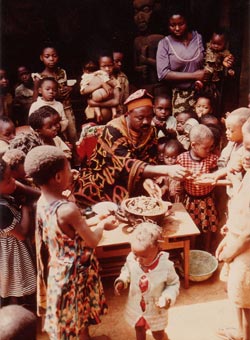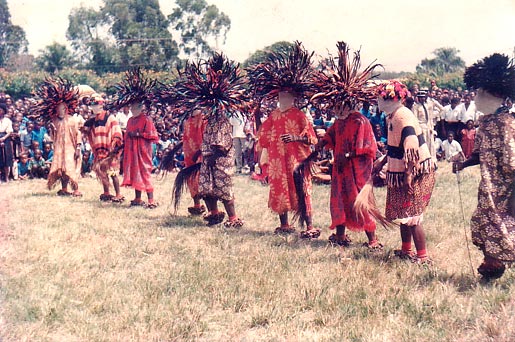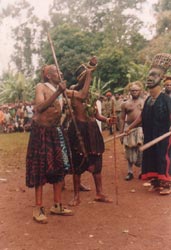 |
 |
 |
| Babungo museum |
 |
 |
 |
 |
| Permanent exhibition |
 The Kingdom, myth, legend and history The Kingdom, myth, legend and history |
 Society and religion Society and religion |
 Arts and technics Arts and technics |
 Artist and craftmen Artist and craftmen |
 Babungo, itineraries of collective memory. Babungo, itineraries of collective memory. |
 |
 |
 |
| Informations |
 |
 |
|
Arts and Technics
Statues and Furniture
The statues in the round, of which about two dozen are presented in the exhibition, are generally anthropomorphic. Some are life-size. They are mainly realistic, dynamic, vigorous and expressive. Some are clad in beads and cowries. They represent figures (kings, queens, princesses, notables. retainers, guardians, warriors etc.) bearing the headdresses and insignia relative to their attributions. Face and eyes express, depending on the case: serenity, majesty, vivaciousness, threat or mystery etc. The motifs decorating the surfaces of the works (sometimes polished) are schematised, with a geometric tendency.

 Interior view of the Babungo museum Interior view of the Babungo museum
They can also be figurative. The sculptures are of a great variety as far as their styles, shapes and ritual functions in the community are concerned (cults of royal ancestors, divining, healing, justice, twin worship, warrior ceremonies, agricultural and fertility rites). They are not all exhibited to the public and those that are associated with an occult power are often kept away from indiscrete eyes. We can note that several other figures are not functional or do not have any religious function. The majority of the statues displayed were made a long time after the reigns of the kings and queens represented; they are therefore not always contemporary of the people they represent.
This is made up of portable stools (sometimes covered with beads and cowries), ceremonial thrones with large backrests, beds and tables, all very well sculpted. The main pieces are decorated with geometric shapes. Animal figures executed with harmony and rhythm, in a rich and complex composition. The shape, cut and decoration of the seat depend on the rank and place of the individual or collective owner in the community. From his accession, the heir (fon or notable) who succeeds his father has a seat made which keeps a commemorative value even after his death. Stools and thrones of the fon appear in different ceremonies and royal cults, and have to be included amongst the most impressive of the symbols of royalty in Babungo and the whole of the Grassland.
| |
 |
Commemorative statue throne of king and wife (fuan Forting and nah)
|
|
Musical Instruments
In Babungo, different musical instruments made of wood, metal or ivory are used in leisure or for various activities of the social life at court. Many of them belonging to the fon, the notables and secret societies play a liturgical role, accompanying or giving rhythm to songs, dances and processions. Some iron specimens are alleged to have taken part in the foundation of the kingdom. Here, some of the objects (drums, harps, flutes, gongs) have a sacred character and have been sanctified by sacrifices and magical practices. In this case, it is dangerous and forbidden to look at them, especially when they emit sound. Of these numerous musical instruments, the most important in Babungo social and religious life are the gongs, flutes, drums and harps, at times richly decorated.

 Male and female drums used during a ceremony Male and female drums used during a ceremony
The kwifo, made up of two tall wrought iron gongs, connected by a metal handle often reinforced and embellished by ties, is the most sacred instrument in the Grassland. It is associated with the tifuan. The simple or sculpted ivory horns belong personally to the fon. They can only be played when a grave ranger threatens Babungo. The smaller and richly decorated horns are used by the heads of the warrior societies. The cylindrical bamboo flute, which can at times be decorated with beads, is a sacred instrument that is sometimes played together with gongs. The slit and membrane drums are remarkable by their dimensions, which can be highly impressive, and the extraordinary wealth of their decoration.
| |
 |
Single gong with human figure (fengeng)
|
|
Containers
| In Babungo, the main materials used to make containers are clay, both baked and unbaked, wood and other materials of plant origin such as fibres, then metal and ivory, offering artists countless possibilities to diversify their production. Several techniques, which formerly flourished in the area, such as pottery, have almost disappeared. There exist a great variety of containers (pots, vases, cups, jars, bowls, pitchers, amphora, bags, calabashes, pipes etc.), each having a specific purpose, whether for cooking or for other uses (for example as ritual material or as ceremonial objects).The containers are used to keep or prepare products for the cult or of prestige and, belonging to the fon and notables, are richly and carefully executed and decorated with geometric or symbolic figurative motifs which can be exuberant at times. The pipes, baked clay containers and wooden recipients are the most characteristic containers of the royal treasure of Babungo. Horns, pipes, calabashes acting as supports for various motifs (men, animals, geometric motifs) and sometimes made of valuable materials are used in everyday and/or cultural life by the court sometimes as emblems of royal authority and the unity of the country. |
|
 |
| |
|
 King Zofua II during a ceremony King Zofua II during a ceremony |
| |
 |
Royal pipe with animal and human figures (yikeng)
|
|
| |
 |
Royal smoking pipe (yikeng)
|
|
Masks, Costumes and Personal Adornments
Masks are of a great diversity both on the morphological level and as far as their political, social, religious, therapeutic, ritual and judicial functions are concerned. Hundreds of masks are to be found in the royal palace of Babungo and in the treasures of notables and secret societies. The specimens on display are anthropomorphic, zoomorphic, anthropo- zoomorphic and hybrid. Generally they are richly decorated and in an expressionist style. Some are covered with cowries and multicoloured beads. Each mask belongs here to a specific society, which uses it during processions, dances or ceremonies.

 Masked dancers at a death cermony Masked dancers at a death cermony
It has to evoke and proof the presence of the supernatural if possible and at times even entertains. It also includes in addition to the woodenhead or fabric hood that conceals the face, the costumes and accessories that are part of it. It is one of the most remarkable symbolic expressions of the art of Babungo.
The sculpted staffs, ceremonial spears, the dance whips, the panther skins that are worked or not, the headdresses, the necklaces, armlets and other adornments are used in everyday life and / or cultural life at the court as emblems or royal authority and of the unity of the country.
Some of these objects are made and decorated very meticulously. In general they have important rituals and ceremonial functions in Babungo, apart from some contemporary pieces, which are used for reasons of prestige. |
|
 |
| |
|
 Enthronament veremony of the King Ndofoa Zofoa III Enthronament veremony of the King Ndofoa Zofoa III |
| |
 |
Zoomorphic helmet mask (toh mekome ngonji)
|
|
[ Top page ] |



![]() Interior view of the Babungo museum
Interior view of the Babungo museum

![]() Male and female drums used during a ceremony
Male and female drums used during a ceremony 

![]() Masked dancers at a death cermony
Masked dancers at a death cermony 


















































